Reverse osmosis is one of the most thorough and effective water treatment solutions – with one catch. While most people love the idea of drinking purified water that’s free of harmful contaminants, they’re not so keen on the idea of having water’s essential minerals removed, too.
Unfortunately, it’s in the nature of a reverse osmosis system to remove everything, and that includes the good stuff.
It’s not the end of the world, though, as there are several options you can use to remineralize reverse osmosis water, and some of them are so easy that you won’t even have to make any extra effort.
Let’s take a look at the ins and outs of how to remineralize reverse osmosis water.
Table of Contents
🤔 What Minerals Does Reverse Osmosis Remove?
Reverse osmosis systems are capable of removing more than 99.9% of all total dissolved solids (TDS) from water, so it’s hardly a surprise that healthy minerals are removed during the process.
Our tap water contains mineral particles like calcium and magnesium, which we need for strong, healthy bones and teeth and to regulate blood pressure, muscles and nerve function. Low levels of salt, potassium and phosphorous are also present in tap water, and are needed for supporting the heart, maintaining the right balance of fluids, and influencing the growth, repair and maintenance of cells all over the body.
All of these essential minerals are removed by reverse osmosis.

📥 Should I Remineralize My Reverse Osmosis Water?
It’s important to keep in mind that, while our bodies need healthy minerals like calcium, magnesium and potassium to survive, we obtain these minerals in much higher concentrations in food.
Whether you choose to add minerals back into your reverse osmosis drinking water won’t make much of a difference either way, health-wise, unless you’re severely deficient in a certain mineral and for some reason can’t make up for it in your diet.
However, if you keep up with the World Health Organization (WHO), you may have seen the report that was released by this organization that discussed the implications of drinking RO water. According to the report, there are certain health risks presented by RO water that makes it unfavorable to drink on a daily basis. Some of the health risks included loss of calcium and magnesium (the two most beneficial minerals found in our drinking water), possible increased toxic metals intake, and effects on metabolism and homeostasis.
What’s important to note is that, while this report is something to be aware of, many of these health risks are only considered “possible”, and some, such as mineral deficiency, can be avoided altogether if you make sure you get plenty of minerals from your diet.
In my opinion, there’s certainly no requirement to add minerals to your RO water; however, you may prefer to do so to improve the water’s taste.
Related: Debunking Myths: Is Reverse Osmosis Water Bad for You?
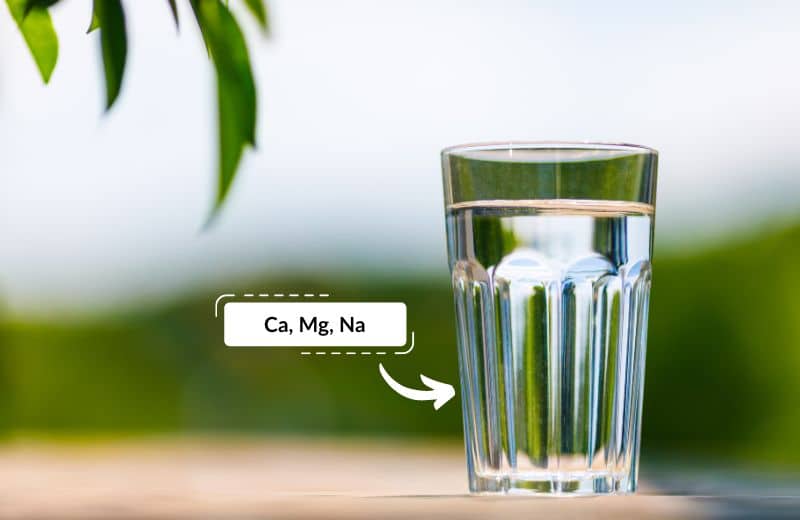
✅ Benefits of Adding Minerals to Reverse Osmosis Water
Remineralizing reverse osmosis water offers the following benefits:
Gives Water an Appealing Flavor
Many people find the taste of reverse osmosis “flat” and unpleasant. Alkaline water with re-added minerals, however, is much more enjoyable to taste, so you’re more likely to reach for a glass of water instead of juice or soda.
Encourages Hydration
If you think that drinking demineralized water will make you less likely to stay hydrated because you’re so put off by the taste, there are obvious benefits of remineralization from a health perspective. RO water tastes flat and boring because it has a lower pH level. Remineralize your water and you’ll increase its pH level – and you’ll probably be more inclined to drink it.
Important for Human Health
As I mentioned earlier, we by no means rely on the trace minerals in our drinking water to survive. However, we can get up to 20% of our daily recommended requirements for minerals like calcium & magnesium from tap water. If drinking remineralized water would give you the peace of mind you needed, then consider a remineralization filter.
🔎 Why are Minerals so Important?
The idea that our bodies need minerals – i.e. the organic substances found in rocks and soil – does seem a little crazy. But you should never underestimate the importance of the role of minerals in the human body. Let’s take a quick look at the minerals that can be found in drinking water and why we need them individually.
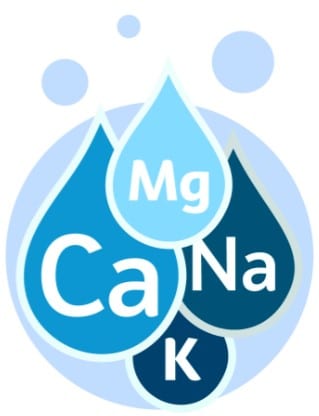
Calcium
Calcium, or calcium carbonate, is considered the most essential mineral in the body because it’s the most common. It can be found all over the body, including the bones and teeth.
We need calcium for muscle and heart contraction, necessary blood clotting, hormone regulation, and nervous system functioning. Many of us only know calcium as an essential mineral for healthy teeth and bones, but this mineral is actually needed for almost every single process in the human body. Being deficient in calcium can result in brittle bones, convulsions, and even heart problems.
Magnesium
Magnesium is another essential mineral that’s equally as necessary as calcium. It helps to stimulate and control hundreds of biochemical reactions and, alongside calcium, can help to develop and maintain healthy bones.
Being deficient in this mineral can result in a number of health issues, from initial symptoms such as nausea, fatigue and weakness to long-term effects like seizures, muscle cramps and numbness, and heart disturbances.
Trace Minerals: Sodium, Potassium and Phosphorous
Along with magnesium and calcium, water also contains trace minerals, such as sodium, potassium and phosphorous.
Sodium (salt) is needed in small quantities by the human body for muscle contraction and nerve impulse regulation. We also need salt to balance the minerals and water in the body.
Potassium, like sodium, helps the muscles to contract and the nerves to function correctly. It also helps to regulate heartbeat.
Though not as necessary as calcium and magnesium, phosphorous is also needed for the formation of teeth and bones. It also helps the body to make protein and plays a role in how the body utilizes fats and carbohydrates.
📖 How to Remineralize RO Water
Trace Mineral Drops
The cheapest method of remineralizing your water is to add trace minerals in the form of drops. You have to know where to look for these trace mineral drops, as some are definitely better than others.
Look for trace mineral drops from established manufacturers that have put decades of research into the products, such as the Quinton Wellness drops.
Depending on the product you go for, you may be required to add mineral drops to your glass of water before drinking, or you may be able to add minerals to a large quantity of water in a pitcher or container. A single order of mineral drops costs between $20 and $40 (again brand depending), and can last for weeks, sometimes even months, at a time.
I Recommend: Quinton Liquid Mineral Drops
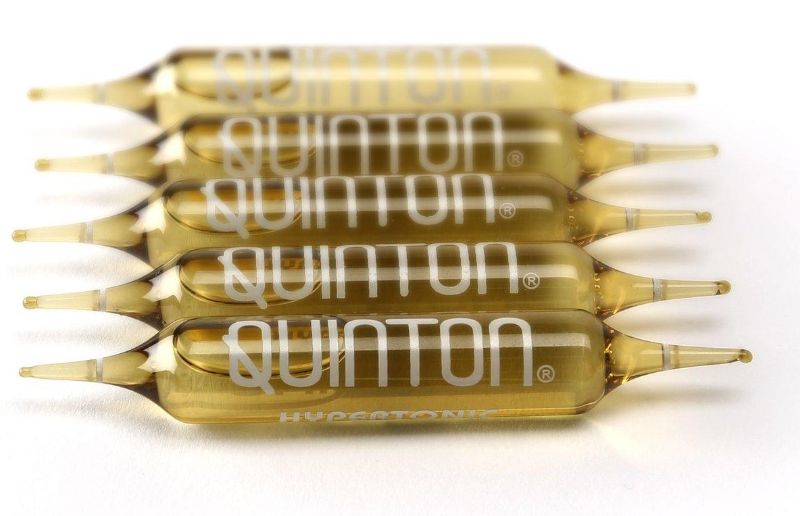
- On the go remineralization
- Improves electrolyte balance
- Helps restore natural rehydration and homeostasis
- Increases cellular response time
- Boosts immune response time
- Enhances brain function & nervous system
Remineralizing Filters
Remineralizing filters are a fantastic hassle-free option for adding minerals back into water if you’re using an under-sink reverse osmosis system.
Many RO systems come with an optional remineralization filter, but if yours doesn’t, you can buy a filter that’s designed for easy installation at your main waterline, just after your reverse osmosis unit. The benefit of a remineralization filter is that it produces alkaline water that comes out of your own faucet, so you don’t have to make the effort to add mineral drops as an afterthought.
Most types of remineralizing filters will remineralize RO water with calcium. Some may also remineralize water with magnesium, and some are even better than this, adding up to five types of mineral back into your RO water.
Remineralization post-filter cartridges can cost as little as $30, with the average price being around $80. You’ll have to replace the filter after approximately every 6 months of use. If you buy an RO system with an included remineralization filter, remember that you’ll pay more for the privilege of mineral-rich RO water. If you’re buying an independent filter, make sure that it comes with its own housing and connections, and isn’t designed to be installed in a dedicated filter system.
Alkaline Water Pitchers
Alkaline water pitchers are another affordable option that can be used to add minerals such as calcium and magnesium to water.
An alkaline water pitcher contains a filter cartridge that adds a measured amount of minerals back into a batch of water. With it being a pitcher design, you won’t get to benefit from immediate remineralized water – you’ll have to add reverse osmosis water from your tap to the pitcher and wait a few minutes for filtration. However, water alkaline pitchers tend to be more affordably priced, at around $20 to $40 per pitcher.
An obvious advantage of alkaline water filters is that they don’t need to be installed at your water line. If you’re looking for a way to remineralize your water with a filter that doesn’t require extra effort (or perhaps even breach the terms of your rental contract), alkaline filters are a great option.
As with remineralizing filters, alkaline water pitcher cartridges will have to be replaced. They typically have shorter lifespans of between 1 and 3 months, but they cost a fraction of the price of a replacement remineralizing filter.
I Recommend: Invigorated Water pH Restore Alkaline Water Pitcher
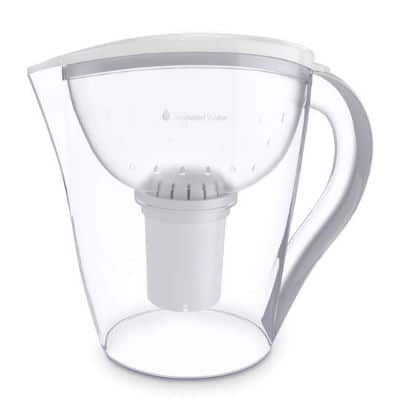
- Last 96 gallons
- High negative Oxidization Reduction Potential (ORP)
- Helps increased immunity and energy levels
- Adds selenium & calcium
- May assist with improved metabolism
Alkaline Water Bottles
For on-the-go access to remineralized reverse osmosis water, an alkaline water bottle is a great choice.
Again, if you choose to remineralize your water with an alkaline water bottle, there’s nothing to set up. Simply fill your bottle with RO water and bring it with you to work (or simply to another room in your house). The bottle contains a filter that will increase water’s pH level, adding minerals such as calcium and magnesium to improve its taste.
You’d probably assume that these water bottles are on the ugly side of practical, but they’re actually pretty nice to look at on the whole.
Generally, alkaline water bottles are priced similarly to pitchers, at around $30 to $50 for a single bottle and filter. Filters need replacing roughly every 6 weeks, though this may vary depending on the manufacturer and the concentration of minerals that are added to your water.
Pink Himalayan Salt
Here’s an option you might not have considered before: pink Himalayan salt. Because Himalayan salt has a naturally high trace mineral content, including calcium, magnesium and potassium, it’s actually a great solution for adding these minerals back into RO water.
To produce remineralized water with pink Himalayan salt, you’ll need to add Himalayan salt to a glass jar, filling it to around 1/4 full, then adding water to fill the jar entirely and leaving it to sit for up to 24 hours. This produces something known as sole water, and has more benefits than just remineralizing water – it’s also said to balance the body’s negatively and positively charged ions, helping to improve overall health.
If remembering to prepare a batch of sole water sounds like too much effort to you, you might want to give this one a miss. However, if you like the sound of the benefits of adding Himalayan salt to your water, go for it! This salt is widely available online. Just make sure to follow guidelines closely, as too much salt in your water could be dangerous.
Obvious disclaimer here: pink Himalayan salt is not the same thing as your average table salt. It has a much lower sodium content, for one thing, and it’s also very mineral-dense, which most salt isn’t.
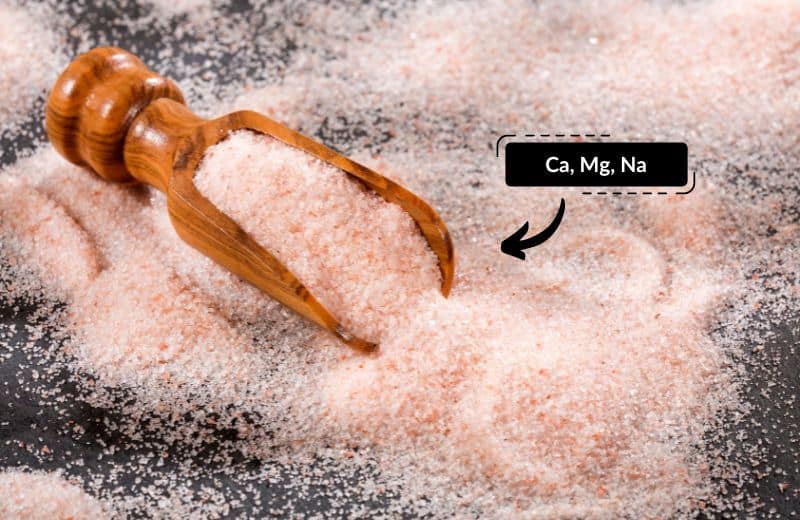
❔ Frequently Asked Questions
How do RO systems remove minerals?
What gives an RO system its name is the reverse osmosis membrane, otherwise known as the semi-permeable membrane. While your general filtered water solution won’t have pores that are small enough to remove the minerals in your drinking water, RO membranes have tiny pores of around 0.0001 microns that can trap even the tiniest contaminants – including minerals.
How do these membranes not become quickly clogged? Because there are several filter stages before water reaches the RO membrane – usually a pre-filter and an activated carbon filter, that have a higher micron rating and are designed to remove larger particles that could quickly clog the membrane’s pores. Additionally, because of the high-pressure operation of a reverse osmosis system, impurities like minerals are likely to bounce back after hitting the membrane, and here, in the RO chamber, they’ll be drained away along with some wastewater.
If I’m adding minerals to RO water, why should I bother with reverse osmosis at all?
Good question – and honestly, it depends on the level of filtered water you’re looking for. Perhaps, for instance, you’re only looking to remove chlorine and lead from your water; in which case, a carbon filter cartridge alone may do the trick – and it won’t remove those beneficial minerals, saving you the job of remineralization. If, however, it’s a must in your eyes that you remove the broadest range of contaminants from water, only an RO system may be able to achieve what you’re looking for. In that case, you’ll have to remineralize RO water should you still want to benefit from these minerals.
How else can I drink my minerals?
If you’d rather not bother with the effort of remineralizing your RO water, there are plenty of ways you can still get some of your daily mineral requirements from your beverages. Why not add mineral-rich green powder or green blends to your filtered water for a morning pick-me-up? You don’t have to add the powder to every glass of water you drink, as one serving per day should be more than enough.
You could also make a juice or smoothie to drink in the morning or evening from fruits and veggies that are naturally rich in healthy minerals. You’ll get way more minerals than you would from drinking remineralized RO water.
How do I add a remineralization filter to my reverse osmosis system?
If you have an under-sink RO system and you want to add an independent filter for remineralization, you will usually just need to connect the filter to the “outgoing” side of your RO system so that remineralization can take place before water passes back towards your faucet. You may need extra fittings or connectors from your local DIY store for the job.
Does reverse osmosis water leach minerals from our bodies?
If you’ve read the WHO report on filtered RO water, you’re probably concerned about one thing in particular: that this type of filtered water can leach minerals out of our bodies, making us more likely to be deficient.
It’s wise to note that the research to support this claim on the report is ongoing. Studies can often suggest an outcome based on a reported trend, and suggestions are often proved wrong with more intensive research.
What we do know, however, is that RO water is more likely to leach heavy metals from pipes, which is why it’s best to install an RO filter underneath your kitchen sink and make sure you’re not using dangerous pipes, like those made from lead, to carry your water (which is a given whether you’re drinking RO water or not).
What’s the difference between remineralized and alkalized water?
When you remineralize your water, as the name “remineralize” suggests, your primary goal is to add minerals back into your water. One of the benefits of this is that water tends to be more alkalized as a result. However, you can also alkalize your water by raising its pH without necessarily adding any minerals.
If your goal is to consume minerals in your drinking water, you need to remineralize your water. If you simply like the taste of alkalized water, you could choose to alkalize it instead.

